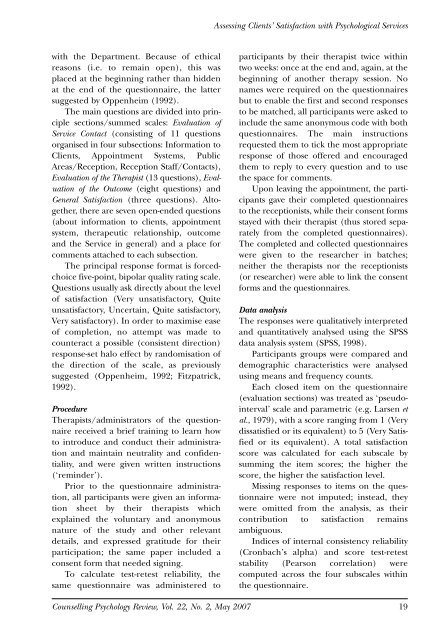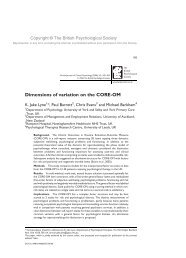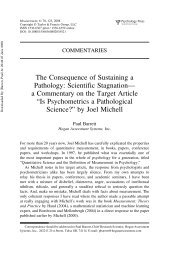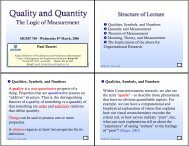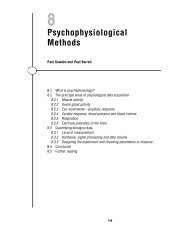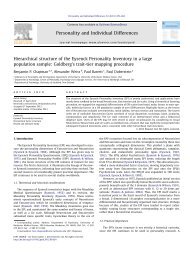Counselling Psychology Review - Paul Barrett
Counselling Psychology Review - Paul Barrett
Counselling Psychology Review - Paul Barrett
Create successful ePaper yourself
Turn your PDF publications into a flip-book with our unique Google optimized e-Paper software.
Assessing Clients’ Satisfaction with Psychological Services<br />
with the Department. Because of ethical<br />
reasons (i.e. to remain open), this was<br />
placed at the beginning rather than hidden<br />
at the end of the questionnaire, the latter<br />
suggested by Oppenheim (1992).<br />
The main questions are divided into principle<br />
sections/summed scales: Evaluation of<br />
Service Contact (consisting of 11 questions<br />
organised in four subsections: Information to<br />
Clients, Appointment Systems, Public<br />
Areas/Reception, Reception Staff/Contacts),<br />
Evaluation of the Therapist (13 questions), Evaluation<br />
of the Outcome (eight questions) and<br />
General Satisfaction (three questions). Altogether,<br />
there are seven open-ended questions<br />
(about information to clients, appointment<br />
system, therapeutic relationship, outcome<br />
and the Service in general) and a place for<br />
comments attached to each subsection.<br />
The principal response format is forcedchoice<br />
five-point, bipolar quality rating scale.<br />
Questions usually ask directly about the level<br />
of satisfaction (Very unsatisfactory, Quite<br />
unsatisfactory, Uncertain, Quite satisfactory,<br />
Very satisfactory). In order to maximise ease<br />
of completion, no attempt was made to<br />
counteract a possible (consistent direction)<br />
response-set halo effect by randomisation of<br />
the direction of the scale, as previously<br />
suggested (Oppenheim, 1992; Fitzpatrick,<br />
1992).<br />
Procedure<br />
Therapists/administrators of the questionnaire<br />
received a brief training to learn how<br />
to introduce and conduct their administration<br />
and maintain neutrality and confidentiality,<br />
and were given written instructions<br />
(‘reminder’).<br />
Prior to the questionnaire administration,<br />
all participants were given an information<br />
sheet by their therapists which<br />
explained the voluntary and anonymous<br />
nature of the study and other relevant<br />
details, and expressed gratitude for their<br />
participation; the same paper included a<br />
consent form that needed signing.<br />
To calculate test-retest reliability, the<br />
same questionnaire was administered to<br />
participants by their therapist twice within<br />
two weeks: once at the end and, again, at the<br />
beginning of another therapy session. No<br />
names were required on the questionnaires<br />
but to enable the first and second responses<br />
to be matched, all participants were asked to<br />
include the same anonymous code with both<br />
questionnaires. The main instructions<br />
requested them to tick the most appropriate<br />
response of those offered and encouraged<br />
them to reply to every question and to use<br />
the space for comments.<br />
Upon leaving the appointment, the participants<br />
gave their completed questionnaires<br />
to the receptionists, while their consent forms<br />
stayed with their therapist (thus stored separately<br />
from the completed questionnaires).<br />
The completed and collected questionnaires<br />
were given to the researcher in batches;<br />
neither the therapists nor the receptionists<br />
(or researcher) were able to link the consent<br />
forms and the questionnaires.<br />
Data analysis<br />
The responses were qualitatively interpreted<br />
and quantitatively analysed using the SPSS<br />
data analysis system (SPSS, 1998).<br />
Participants groups were compared and<br />
demographic characteristics were analysed<br />
using means and frequency counts.<br />
Each closed item on the questionnaire<br />
(evaluation sections) was treated as ‘pseudointerval’<br />
scale and parametric (e.g. Larsen et<br />
al., 1979), with a score ranging from 1 (Very<br />
dissatisfied or its equivalent) to 5 (Very Satisfied<br />
or its equivalent). A total satisfaction<br />
score was calculated for each subscale by<br />
summing the item scores; the higher the<br />
score, the higher the satisfaction level.<br />
Missing responses to items on the questionnaire<br />
were not imputed; instead, they<br />
were omitted from the analysis, as their<br />
contribution to satisfaction remains<br />
ambiguous.<br />
Indices of internal consistency reliability<br />
(Cronbach’s alpha) and score test-retest<br />
stability (Pearson correlation) were<br />
computed across the four subscales within<br />
the questionnaire.<br />
<strong>Counselling</strong> <strong>Psychology</strong> <strong>Review</strong>, Vol. 22, No. 2, May 2007 19


